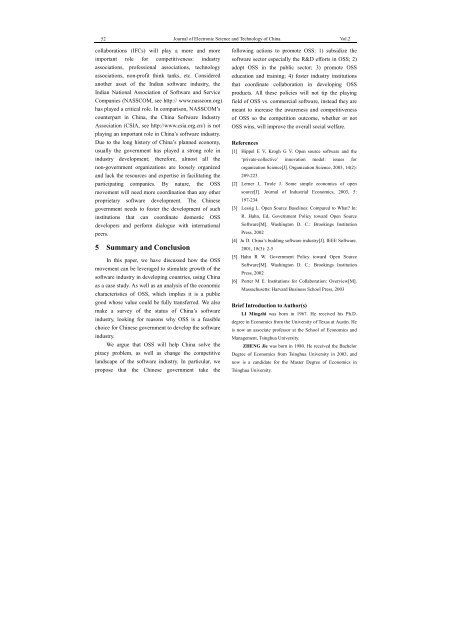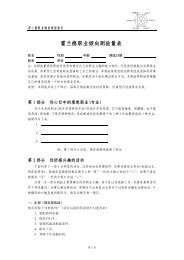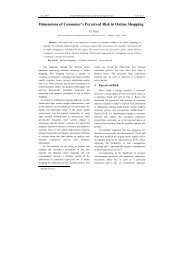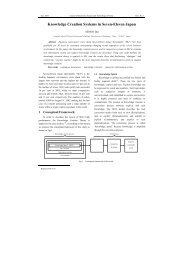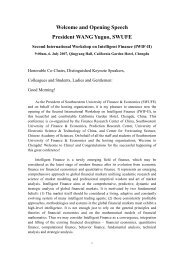from word document
from word document
from word document
Create successful ePaper yourself
Turn your PDF publications into a flip-book with our unique Google optimized e-Paper software.
52Journal of Electronic Science and Technology of China Vol.2collaborations (IFCs) will play a more and moreimportant role for competitiveness: industryassociations, professional associations, technologyassociations, non-profit think tanks, etc. Consideredanother asset of the Indian software industry, theIndian National Association of Software and ServiceCompanies (NASSCOM, see http:// www.nasscom.org)has played a critical role. In comparison, NASSCOM’scounterpart in China, the China Software IndustryAssociation (CSIA, see http://www.csia.org.cn/) is notplaying an important role in China’s software industry.Due to the long history of China’s planned economy,usually the government has played a strong role inindustry development; therefore, almost all thenon-government organizations are loosely organizedand lack the resources and expertise in facilitating theparticipating companies. By nature, the OSSmovement will need more coordination than any otherproprietary software development. The Chinesegovernment needs to foster the development of suchinstitutions that can coordinate domestic OSSdevelopers and perform dialogue with internationalpeers.5 Summary and ConclusionIn this paper, we have discussed how the OSSmovement can be leveraged to stimulate growth of thesoftware industry in developing countries, using Chinaas a case study. As well as an analysis of the economiccharacteristics of OSS, which implies it is a publicgood whose value could be fully transferred. We alsomake a survey of the status of China’s softwareindustry, looking for reasons why OSS is a feasiblechoice for Chinese government to develop the softwareindustry.We argue that OSS will help China solve thepiracy problem, as well as change the competitivelandscape of the software industry. In particular, wepropose that the Chinese government take thefollowing actions to promote OSS: 1) subsidize thesoftware sector especially the R&D efforts in OSS; 2)adopt OSS in the public sector; 3) promote OSSeducation and training; 4) foster industry institutionsthat coordinate collaboration in developing OSSproducts. All these policies will not tip the playingfield of OSS vs. commercial software, instead they aremeant to increase the awareness and competitivenessof OSS so the competition outcome, whether or notOSS wins, will improve the overall social welfare.References[1] Hippel E V, Krogh G V. Open source software and the‘private-collective’ innovation model: issues fororganization Science[J]. Organization Science, 2003, 14(2):209-223[2] Lerner J, Tirole J. Some simple economics of opensource[J]. Journal of Industrial Economics, 2003, 5:197-234[3] Lessig L. Open Source Baselines: Compared to What? In:R. Hahn, Ed, Government Policy toward Open SourceSoftware[M]. Washington D. C.: Brookings InstitutionPress, 2002[4] Ju D. China’s budding software industry[J]. IEEE Software,2001, 18(3): 2-5[5] Hahn R W. Government Policy toward Open SourceSoftware[M]. Washington D. C.: Brookings InstitutionPress, 2002[6] Porter M E. Institutions for Collaboration: Overview[M].Massachusetts: Harvard Business School Press, 2003Brief Introduction to Author(s)LI Mingzhi was born in 1967. He received his Ph.D.degree in Economics <strong>from</strong> the University of Texas at Austin. Heis now an associate professor at the School of Economics andManagement, Tsinghua University.ZHENG Jie was born in 1980. He received the BachelorDegree of Economics <strong>from</strong> Tsinghua University in 2003, andnow is a candidate for the Master Degree of Economics inTsinghua University.


